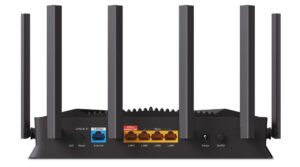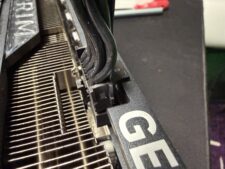Nvidia GeForce RTX 4060 Ti 16GB Review: Does More VRAM Help?
Some would say the Nvidia GeForce RTX 4060 Ti 16GB is the card that Nvidia and its partners don’t want to see reviewed. No add-in board (AIB) partner would send us a card, and Nvidia didn’t sample anyone… so we bought one, at retail, after searching for over a week to find one in stock. Is it one of the best graphics cards? You can probably already guess the answer to that question.
Based on the same Ada Lovelace architecture and with the same core specs as the RTX 4060 Ti Founders Edition, the sole difference is the use of two 2GB memory chips on each memory channel, doubling the capacity to 16GB. More memory should be good in certain workloads, though the 128-bit memory interface remains and will sometimes hold the GPU back.
More critically, tacking on $100 for the extra VRAM represents yet another cynical move from Nvidia. Yes, some people will be willing to pay the price, but Intel’s Arc A770 comes in both 8GB and 16GB variants (albeit with a 256-bit interface), with about a $50 gap in pricing. Put bluntly, Nvidia charges as much as it feels it can get away with, and sometimes more.
There’s no Founders Edition for the 4060 Ti 16GB, which makes the definition of a “reference” card somewhat nebulous. We figure anything available at the base $499 MSRP qualifies, and after looking at the options available at Newegg, Amazon, and elsewhere, we opted for the Gigabyte RTX 4060 Ti 16GB Gaming OC. Other MSRP models include the MSI Ventus 2X and the Zotac Amp (that’s the Across the Spider-Verse bundle, in case that’s a selling point for you).
Supposedly over 20 other 4060 Ti 16GB variants are available from other AIBs, but most are currently out of stock. We figured the triple fans on the Gigabyte card would provide a better overall cooling solution, so let’s hit the speeds and feeds.
| Graphics Card | Gigabyte RTX 4060 Ti 16GB | RTX 4060 Ti 16GB | RTX 4070 | RTX 4060 Ti | RTX 4060 | RTX 3060 Ti | RX 6800 XT | RX 6800 | RX 6750 XT |
|---|---|---|---|---|---|---|---|---|---|
| Architecture | AD106 | AD106 | AD104 | AD106 | AD107 | GA104 | Navi 21 | Navi 21 | Navi 22 |
| Process Technology | TSMC 4N | TSMC 4N | TSMC 4N | TSMC 4N | TSMC 4N | Samsung 8N | TSMC N7 | TSMC N7 | TSMC N7 |
| Transistors (Billion) | 22.9 | 22.9 | 32 | 22.9 | 18.9 | 17.4 | 26.8 | 26.8 | 17.2 |
| Die size (mm^2) | 187.8 | 187.8 | 294.5 | 187.8 | 158.7 | 392.5 | 519 | 519 | 336 |
| SMs / CUs / Xe-Cores | 34 | 34 | 46 | 34 | 24 | 38 | 72 | 60 | 40 |
| GPU Cores (Shaders) | 4352 | 4352 | 5888 | 4352 | 3072 | 4864 | 4608 | 3840 | 2560 |
| Tensor / AI Cores | 136 | 136 | 184 | 136 | 96 | 152 | N/A | N/A | N/A |
| Ray Tracing “Cores” | 34 | 34 | 46 | 34 | 24 | 38 | 72 | 60 | 40 |
| Boost Clock (MHz) | 2595 | 2535 | 2475 | 2535 | 2460 | 1665 | 2250 | 2105 | 2600 |
| VRAM Speed (Gbps) | 18 | 18 | 21 | 18 | 17 | 14 | 16 | 16 | 18 |
| VRAM (GB) | 16 | 16 | 12 | 8 | 8 | 8 | 16 | 16 | 12 |
| VRAM Bus Width | 128 | 128 | 192 | 128 | 128 | 256 | 256 | 256 | 192 |
| L2 / Infinity Cache | 32 | 32 | 36 | 32 | 24 | 4 | 128 | 128 | 96 |
| ROPs | 48 | 48 | 64 | 48 | 48 | 80 | 128 | 96 | 64 |
| TMUs | 136 | 136 | 184 | 136 | 96 | 152 | 288 | 240 | 160 |
| TFLOPS FP32 (Boost) | 22.6 | 22.1 | 29.1 | 22.1 | 15.1 | 16.2 | 20.7 | 16.2 | 13.3 |
| TFLOPS FP16 (FP8) | 181 (361) | 177 (353) | 233 (466) | 177 (353) | 121 (242) | 65 (130) | 41.4 | 32.4 | 26.6 |
| Bandwidth (GBps) | 288 | 288 | 504 | 288 | 272 | 448 | 512 | 512 | 432 |
| TDP (watts) | 160 | 160 | 200 | 160 | 115 | 200 | 300 | 250 | 250 |
| Launch Date | Jul 2023 | Jul 2023 | Apr 2023 | May 2023 | Jul 2023 | Dec 2020 | Nov 2020 | Nov 2020 | May 2022 |
| Launch MSRP | $499 | $499 | $599 | $399 | $299 | $399 | $649 | $579 | $549 |
| Online Price | $500 | $500 | $590 | $374 | $300 | $335 | $520 | $440 | $350 |
The RTX 4060 Ti 16GB has the same specs as the 8GB variant, other than VRAM capacity. The Gigabyte model we’re using for this review gets an extra 60 MHz for its boost clock, which in practice usually won’t matter much — the 4060 Ti Founders Edition averaged just under 2.8 GHz across our test suite, while the Gigabyte card was closer to 2.75 GHz. Paper specs aren’t everything, in other words.
As you can imagine, there’s quite a bit of healthy competition for the 4060 Ti 16GB. AMD’s RX 6800 can now be picked up starting at $450, while the RX 6800 XT has frequently been on sale for $500 over the past couple of months — the cheapest price at the time of writing is $520. Previous generation RTX 3070 and RTX 3070 Ti cards also cost less than the 4060 Ti 16GB now — as they should, considering the overall performance. We’ll also toss in some Intel Arc cards for the benchmarks as well, but we’ll get to those in a few pages.
The bump in memory capacity will definitely help, but raw bandwidth remains a potential problem. If you’re playing games that don’t need or use more than 8GB of VRAM, we’d expect similar performance — with a bit of wiggle room since we’re comparing a factory overclocked card to the reference models. 1440p, and especially 4K, could benefit from the extra VRAM, but Nvidia isn’t marketing the RTX 4060 Ti as a 1440p or 4K gaming solution. That’s probably thanks to its lack of compute and bandwidth, even though the RTX 3060 Ti and RTX 3070 both targeted 1440p.
Note also that the 16GB cards, in the same power envelope, may perform slightly worse than the 8GB models. We definitely saw that in some of our benchmarks. It’s not clear precisely how much power the extra memory uses, but it’s more than zero watts, and that could, in some cases, reduce the maximum boost clocks. Or perhaps it’s just the Gigabyte card in particular, but the difference in favor of the 8GB Founders Edition was generally in the low single-digit percentage points and was basically within the margin of error.
Here’s the block diagram for the RTX 4060 Ti, along with the full AD106 chip. Nothing is changed for the RTX 4060 Ti 16GB. There’s one disabled NVDEC (Nvidia Decoder) block and two disabled SMs (Streaming Multiprocessors). Manufacturing would be more complex, as GDDR6 chips need to be mounted on both sides of the PCB. That used to be relatively common, but in recent years such cards are usually professional models or “prosumer” cards like the Titan series.
All the other Ada Lovelace architectural features are present, including the heavily marketed DLSS 3 Frame Generation. If you’re willing to trade latency for a bit more visual smoothness, that’s what it gives you, but the performance charts with DLSS 3 enabled can be rather misleading in our experience. A 50% or larger boost in frames via DLSS 3 doesn’t feel 50% faster — we’d say more like 10–20 percent at best.
Besides gaming, VRAM capacity can also be a factor in AI workloads. Many large language models (LLMs) benefit from lots of memory, and 8GB isn’t enough for even “medium” sized models in many cases. I have to wonder if some of the RTX 4060 Ti 16GB scarcity at launch was from AI researchers and companies grabbing it for experimentation just because of its memory capacity. It still feels like a bit of a throwback to 2021, where GPUs just were sold out at launch, though at least now there are cards priced at MSRP.
Let’s go ahead and move on to the specifics of the Gigabyte RTX 4060 Ti Gaming OC.














